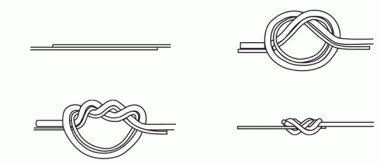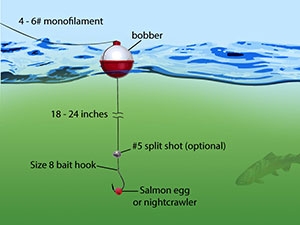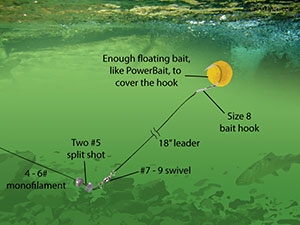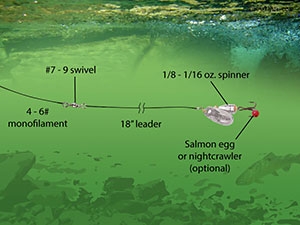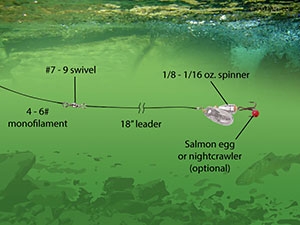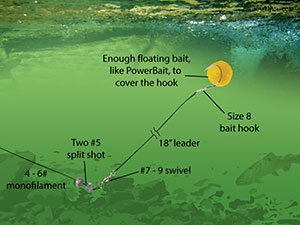
Learn to fish
There are several ways to begin your fishing journey – you can join a friend or family member on their fishing trip, you can attend a free ODFW fishing event, or you can strike out on your own (don’t worry, you can do this). In this article you'll find out what gear you need and where to go fishing in Oregon, along with a few basics of the sport.

What you’ll need
A fishing license
If you’re ready to dive in with both feet, an annual fishing license is the most economical. If you’re not sure fishing will be your thing you can opt for a daily license.
- Children under age 12 do not need a license to fish for trout in Oregon.
- Free Fishing Weekend is always the first full weekend in June --no license is required to fish, crab or clam anywhere in Oregon. Go on your own, or join one of the many events that weekend where all the equipment and instruction is provided.
A copy of the sport fishing regulations
There are rules for fishing in Oregon so be sure to check the regulations before you head out. First, read the general rules for the zone you’ll be fishing in, and then check to see if there are any special rules for the lake, river, stream or pond you plan to fish in that zone.
At first glance, Oregon’s fishing regulations (which cover trout, salmon, steelhead and warmwater fish) can appear a bit overwhelming. However, if you’re targeting a specific species or water body, the regulations become much easier to comprehend.
ALWAYS check the regulations (book or online) for any special regulations for the place you will be fishing.
Rod, reel and tackle
Ok, you’ve decided to go fishing– now you’re going to need some gear.
Rods, reels and lines
Most modern rods are made of graphite and come in a variety of lengths and actions. Longer heavy action rods are good for casting large lures to large fish, while shorter lighter action rods excel at putting smaller lures in front of small fish.
- A 5.5- to 6-foot, light action rod designed for 4- to 6-lb test line is a good all-around choice for most warmwater and trout fishing.
- You’ll want to pair your rod with a matching reel. Consider one of these types:
- Spincaster reels are closed-faced spinning reels with an easy-to-use thumb button that opens the bail for easing casting. These are a great choice for kids or other novice anglers.
- Spinning reels are versatile, open-faced reels with an exposed “bale” you have to open and close when casting. These reels also are easy to use and can be a good choice for beginners. As you become a better caster, you may find you can cast longer and more accurately with a spinning reel than with a spincaster reel.
- Load your reel with 4- to 6-lb test monofilament line. If you purchase your gear somewhere with a well-stocked fishing section they will probably put the line on the reel for you.
- You also can find “outfits” that include the rod, reel and line all in one package.
Bait and lures
In Oregon, some water bodies allow the use of bait and others are restricted to artificial flies and lures. Be sure to check the regulations before you go fishing.
- Bait includes worms, salmon eggs, crickets and grasshoppers, and dough-like baits (such as PowerBait). “Bait” also includes soft plastic or rubber imitations of worms or eggs, or other rubber or soft plastic imitations.
- Popular baits include PowerBait, Pautzkes Balls O’ Fire salmon eggs, and nightcrawlers.
- The use of live fish or other live bait is illegal in most circumstances in Oregon, please review the general statewide regulations for clarification.
- Artificial flies and lures include spinners, spoons, jigs and hard-plastic imitations of minnows, leeches other favorite fish foods.
- Popular lures include spinners such as Rooster Tails, Panther Martins and Blue Foxes (1/8 and 1/16 ounce size) and spoons such as Kastmasters, Krocodiles and Dick Nites in smaller sizes.
Weights, bobbers, hooks and swivels
You’ll need a handful of other tackle items to put all the pieces together and make your bait or lure “fish” the way you want it to. You’ll see how everything goes together in the next section.
For bait fishing, pick up:
- Hooks – obviously these hold your bait. They come in lots of styles, sizes and even colors. Remember, the larger the size number, the small the hook. Start with a package of size 8 bait hooks.
- Bobbers – help suspend your bait in the water, and also bounce, wiggle, dive or otherwise indicate a fish is taking your bait. A couple of old-time red/white bobbers will do but other colors or styles are available.
- Split shot – a couple attached to your line or leader will help hold your bait near the bottom, where fish often hang out. A package of #5 lead split shot should do.
For lure fishing, it’s a little simpler – get a package of size 7 or 9 swivels. These will allow your spinner or spoon to spin freely in the water without twisting up the fishing line.
Depending on how you rig your bait or lure, you might also need a leader. This is a piece of monofilament that goes from your main line to the hook or lure, often with a swivel in between. You can cut off a piece of your main line to use as a leader, or buy special leader material on a spool.
How to do it
Attend a free Family Fishing Event. We’ll supply all the gear you’ll need to fish and even show you how to use it. Come by yourself or bring the whole family. Most events are held in the spring at locations throughout the state. The 2018 calendar will be posted in February.
OR
Take yourself fishing. Can’t find a Family Fishing Event convenient for you? It’s easy to get started on your own. Here’s how:
Know some knots
Every angler should know how to tie at least two knots:
Use the improved clinch knot to tie hooks, swivels and spinners to your fishing line.
Use the surgeon’s knot to tie two pieces of line together.
Riggings and fishing techniques for lakes and ponds
Suspending bait under a bobber
Cast out to a likely looking spot and wait for the bobber to wiggle, dive or jerk- set the hook and reel in! This is a good technique when fish are cruising near the surface, or when you want to keep your bait suspended above a weed bed.
Fishing with the bait off the bottom
Cast out to a likely looking spot. The weight will sink to the bottom while the bait will float up and hover 1.5 feet above the bottom. There's no bobber to help you sense a strike, so when you feel a tug on the line - set the hook and reel in!
Casting/retrieving a spinner or spoon
Cast a spinner to a likely looking spot. Let it sink for a minute and begin reeling it in- called retrieving. Vary the amount of time you let the spinner sink and the speed of your retrieve until you find the right combination. When fishing a spoon, lift and drop the rod tip so the spoon rises and falls - called jigging. When a fish strikes, set the hook and reel in!
Riggings and fishing techniques for rivers and streams:
Casting a spinner or spoon
Begin by casting the spinner slightly upstream and reel in any slack line. As the current carries the spinner down river, use the rod to lift as much fishing line off the water as you can to achieve a “natural” drift. Once the spinner has swung toward the shore and is straight down river, begin a moderate retrieve. Spoons can be a good choice in deeper water where they can be “jigged” –after casting, lift the rod up and then let it down so the spoon rises and falls in the water. Be sure to keep your line slack free. When you retrieve a spoon, reel in a little slower to give the spoon better action.
Drifting bait near the bottom
Cast slightly upriver with just enough split shot on the line to get the bait within a few inches of the bottom. Once the bait has swung toward the shore and is straight down river, reel in and cast again. Sometimes adding a bobber will help you keep track of where the bait is drifting, and help you detect a strike.
Where and when to go
Though some waterbodies are only open during certain dates, there are several lakes, rivers and streams that are open year-round.
Easy Angling Oregon describes 101 fishing spots throughout the state selected especially for families and newcomers.
Don’t have much time and want more choices closer to home? Check out our 50 Places to go Fishing… series.
- 50 Places to go Fishing within 60 Minutes of Portland
- 50 places to go fishing within 90 minutes of Bend
- 50 Places to go Fishing within 60 Minutes of Medford
- 50 Places to go Fishing within 60 Minutes of Roseburg
- 50 Places to go Fishing on the South Coast
- 65 Places to go Fishing in Lane County
ODFW stocks over 7 million trout each year for anglers to catch. Find out where those fish are going from the trout stocking schedule.
Get weekly updates on local fishing conditions from the ODFW Recreation Report.
Have additional questions about where to go or what the regulations are? Don’t hesitate to call your local ODFW office – they’re there to help you.
Header photo by Rick Swart




